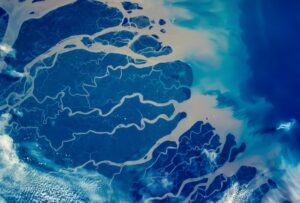New DNA analysis suggests that Otzi the Iceman looked very different than scientists previously believed. The 5,300-year-old mummy is the oldest human body that researchers have found intact. Hikers found his frozen remains in 1991 on the Tisenjoch pass in the Tyrolean Alps, on the border between Italy and Austria.
Scientists have spent considerable time studying Otzi and have now re-sequenced his genome using cutting-edge techniques. The new study found that Otzi had dark eyes, dark skin, was balding, and was in his mid-40s.
“The genome analysis revealed phenotypic traits such as high skin pigmentation, dark eye color, and male pattern baldness that are in stark contrast to the previous reconstructions that show a light-skinned, light-eyed, and quite hairy male,” said co-author Johannes Krause from the Max Planck Institute for Evolutionary Anthropology.

A graphic representation of the latest Otzi findings. Image: Wang et al., Cell Genomics, 2023
A contaminated sample?
Scientists based previous illustrations and reconstructions of Otzi on the first genome study from 2012. That study concluded that Otzi was related to present-day Sardinians, who have light skin and eyes. Traces in the genome connected him with the steppe people, but they arrived in Europe centuries after his death. It is likely that there was contamination by modern human DNA in the 2012 study.
The new study used a different DNA extraction method that reduces contamination. They were able to re-map 90% of the genome. A massive proportion of the iceman’s genes (92%) relate him to the early farmers of Anatolia, in modern-day Turkey. Anatolian farmers began migrating out of the region around 8,000 years ago.
The very high percentage of Anatolian heritage suggests that Otzi’s ancestors could have settled in the mountains and had very little contact with others. “Genetically, his ancestors seem to have arrived directly from Anatolia without mixing with hunter-gatherer groups. The Alps are basically a traffic barrier,” Krause says. It seems Otzi grew up and lived in the area now known as South Tirol in Italy.
That Otzi had darker skin is not altogether surprising. The mummy itself has quite dark skin but scientists had assumed this had darkened during the mummification process. Yet previous research found brown melanin granules in deep layers of the epidermis and Europeans from this time period had much darker skin than modern Caucasian Europeans.
“Early European farmers still had quite dark skin, which changed with time to lighter skin, as an adaption to the changes in climate and diet of the farmers. Farmers consume much less vitamin D compared to hunter-gatherers,” co-author Albert Zink, Head of the Institute for Mummy Studies at Eurac Research, told CNN.

A reconstruction of the Iceman on display at the South Tyrol Museum of Archaeology. Photo: South Tyrol Museum of Archaeology
Male pattern baldness
Though DNA analysis shows markers for male pattern baldness, it is difficult to tell to what extent this had taken place. The remains show near complete baldness but it is very possible this has happened after death. Researchers think that by his death, his hairline had likely receded to a crown.
Each new experiment on Otzi seems to bring new information to light. For example, scientists initially thought Otzi froze to death before a 2001 study found an arrowhead in his shoulder and a head injury. Research done in 2018 showed he had a full stomach when he died and that it contained a well-balanced combination of carbohydrates, proteins, and lipids. He had eaten wild meat, cereals, and a small amount of toxic bracken.
The study gives great insight into the life of Otzi but researchers note that it gives “limited resolution in representing the population history of his time and region,” and that future studies with more samples are required to show whether Otzi is truly representative of his population.






